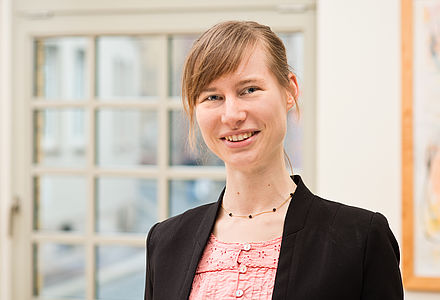Evaluation of Subsidy Programmes
This research group focuses on two main research questions: (i) What is the causal effect of cooperative innovation activities on the performance of firms and regions? (ii) What are the causal effects of public Research and Development (R&D) support schemes on the performance of firms and regions? The first research question concerns the dynamics of firms and regions as a result of their different innovation activities. We apply a micro-based integrative perspective on innovative activities which allows identifying causal effects of cooperative activities on specific outcomes (e. g., patent applications, scientific publications, employment growth, or productivity growth). Concerning the second research question, recent studies mainly focus on the evaluation of one specific subsidy scheme. Research in this group aims to overcome this shortcoming by considering various support schemes. Indicators for the firms’ success are (amongst others) patent applications and employment growth. The results allow insights for the future design of innovation support schemes.
Centre for Evidence-based Policy Advice (IWH-CEP)
Research Cluster
Economic Dynamics and StabilityYour contact

Mitglied - Department Präsidialbereich
EXTERNAL FUNDING
09.2019 ‐ 09.2022
Establishing Evidence-based Evaluation Methods for Subsidy Programmes in Germany (EVA-KULT)
European Regional Development Fund (ERDF)
The project aims at expanding the Centre for Evidence-based Policy Advice at the Halle Institute for Economic Research (IWH-CEP).
01.2018 ‐ 12.2020
Networked growth - Innovative Saxony-Anhalt through digital business models (Competence Center 4.0)
Federal Ministry for Economic Affairs and Energy (BMWI)
01.2017 ‐ 12.2018
Political Participation in Eastern Germany
Federal Ministry for Economic Affairs and Energy (BMWI)
12.2015 ‐ 11.2018
Socio-economic Effects of Research on Innovative Approaches for POC Diagnostics
Federal Ministry of Education and Research (BMBF)
Part of the EXASENS project. Coordinated by the Leibniz Institute of Photonic Technology (IPHT) in Jena, nine Leibniz institutes are working together on researching point-of-care (POC) technology for the prediction and diagnosis of chronic inflammatory respiratory diseases. See press release.
02.2017 ‐ 02.2018
The Importance of Non-University Research Institutions for the Development of Firms and Regions (Be_For_Reg-Projekt)
Federal Ministry of Education and Research (BMBF)
01.2015 ‐ 12.2016
Evaluation of the "Joint Task 'Improving the Regional Economic Structure'" in the Federal State of Saxony-Anhalt
Investitionsbank Sachsen-Anhalt
Refereed Publications
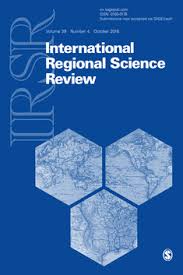
Joint R&D Subsidies, Related Variety, and Regional Innovation
in: International Regional Science Review, No. 3, 2017
Abstract
Subsidies for research and development (R&D) are an important tool of public R&D policy, which motivates extensive scientific analyses and evaluations. This article adds to this literature by arguing that the effects of R&D subsidies go beyond the extension of organizations’ monetary resources invested into R&D. It is argued that collaboration induced by subsidized joint R&D projects yield significant effects that are missed in traditional analyses. An empirical study on the level of German labor market regions substantiates this claim, showing that collaborative R&D subsidies impact regions’ innovation growth when providing access to related variety and embedding regions into central positions in cross-regional knowledge networks.
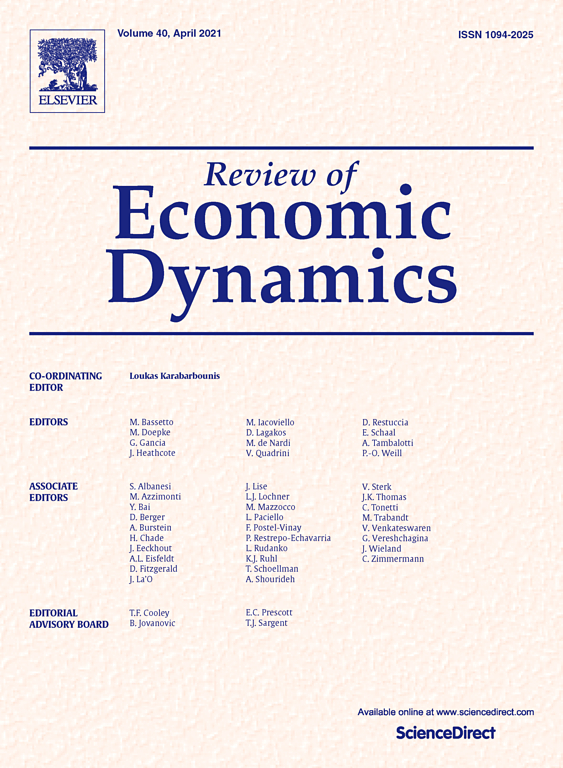
Complex-task Biased Technological Change and the Labor Market
in: Review of Economic Dynamics, April 2017
Abstract
In this paper we study the relationship between task complexity and the occupational wage- and employment structure. Complex tasks are defined as those requiring higher-order skills, such as the ability to abstract, solve problems, make decisions, or communicate effectively. We measure the task complexity of an occupation by performing Principal Component Analysis on a broad set of occupational descriptors in the Occupational Information Network (O*NET) data. We establish four main empirical facts for the U.S. over the 1980–2005 time period that are robust to the inclusion of a detailed set of controls, subsamples, and levels of aggregation: (1) There is a positive relationship across occupations between task complexity and wages and wage growth; (2) Conditional on task complexity, routine-intensity of an occupation is not a significant predictor of wage growth and wage levels; (3) Labor has reallocated from less complex to more complex occupations over time; (4) Within groups of occupations with similar task complexity labor has reallocated to non-routine occupations over time. We then formulate a model of Complex-Task Biased Technological Change with heterogeneous skills and show analytically that it can rationalize these facts. We conclude that workers in non-routine occupations with low ability of solving complex tasks are not shielded from the labor market effects of automatization.
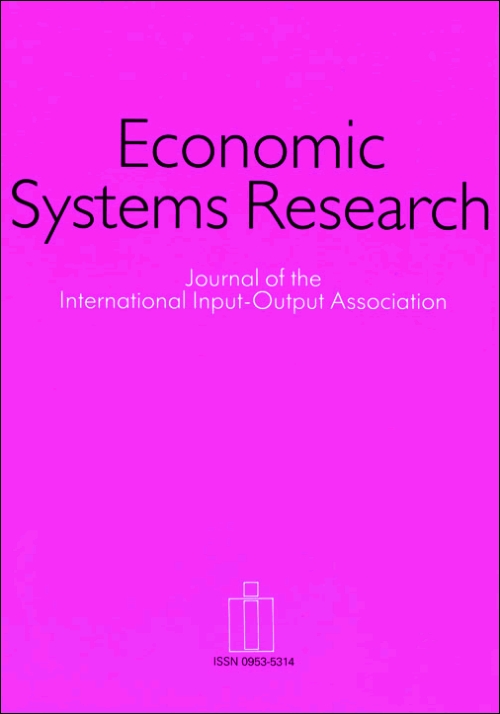
Mapping Potentials for Input-Output Based Innovation Flows in Industrial Clusters – An Application to Germany
in: Economic Systems Research, No. 4, 2016
Abstract
Our paper pursues two aims: first, it presents an approach based on input–output innovation flow matrices to study intersectoral innovation flows within industrial clusters. Second, we apply this approach to the identification of structural weaknesses in East Germany relative to the western part of the country. The case of East Germany forms an interesting subject because while its convergence process after unification began promisingly in the first half of the 1990s, convergence has since slowed down. The existing gap can now be traced mainly to structural weaknesses in the East German economy, such as the absence of strong industrial cluster structures. With this in mind, we investigate whether East Germany does in fact reveal the abovementioned structural weaknesses. Does East Germany possess fewer industrial clusters? Are they less connected? Does East Germany lack specific clusters that are also important for the non-clustered part of the economy?
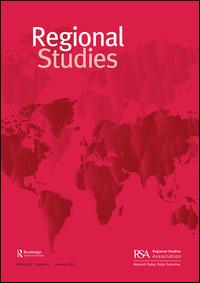
The Importance of Localized Related Variety for International Diversification of Corporate Technology
in: Regional Studies, No. 10, 2016
Abstract
Internationalization of research and development has increased substantially in recent years. This paper analyses the determinants of spatial distribution of foreign technological activities across 96 regions in Germany. It identifies foreign technological activities by applying the cross-border ownership concept to patent applications. The main proposition is that regions with higher related variety of technological activities between sectors attract more foreign technological activities. The estimations show that this is the case in regions characterized by a high overall technological strength. This suggests that related variety facilitates technological diversifications of foreign corporations in regions at the top of the geographic hierarchy.

Burdett–Mortensen Model of on-the-Job Search with Two Sectors
in: Review of Economic Dynamics, Special Issue in Honor of Dale Mortensen 2016
Abstract
The focus of this paper is on the steady state of a two-sector economy with undirected search where employed and unemployed workers can search for jobs, both within a sector and between the sectors. As in the one-sector model, on-the-job search generates wage dispersion among homogeneous workers. The analysis of the two-sector model uncovers a property called constant tension that is responsible for analytical tractability. We characterize the steady state in all cases with constant tension. When time discounting vanishes, constant tension yields the endogenous separation rate in each sector as a linear function of the present value for a worker. The one-sector economy automatically satisfies constant tension, in which case the linear separation rate implies that equilibrium offers of the worker value are uniformly distributed. Constant tension also has strong predictions for worker transitions and value/wage dispersion, both within a sector and between the two sectors. When constant tension does not hold, we compute the steady state numerically and illustrate its properties.
Working Papers
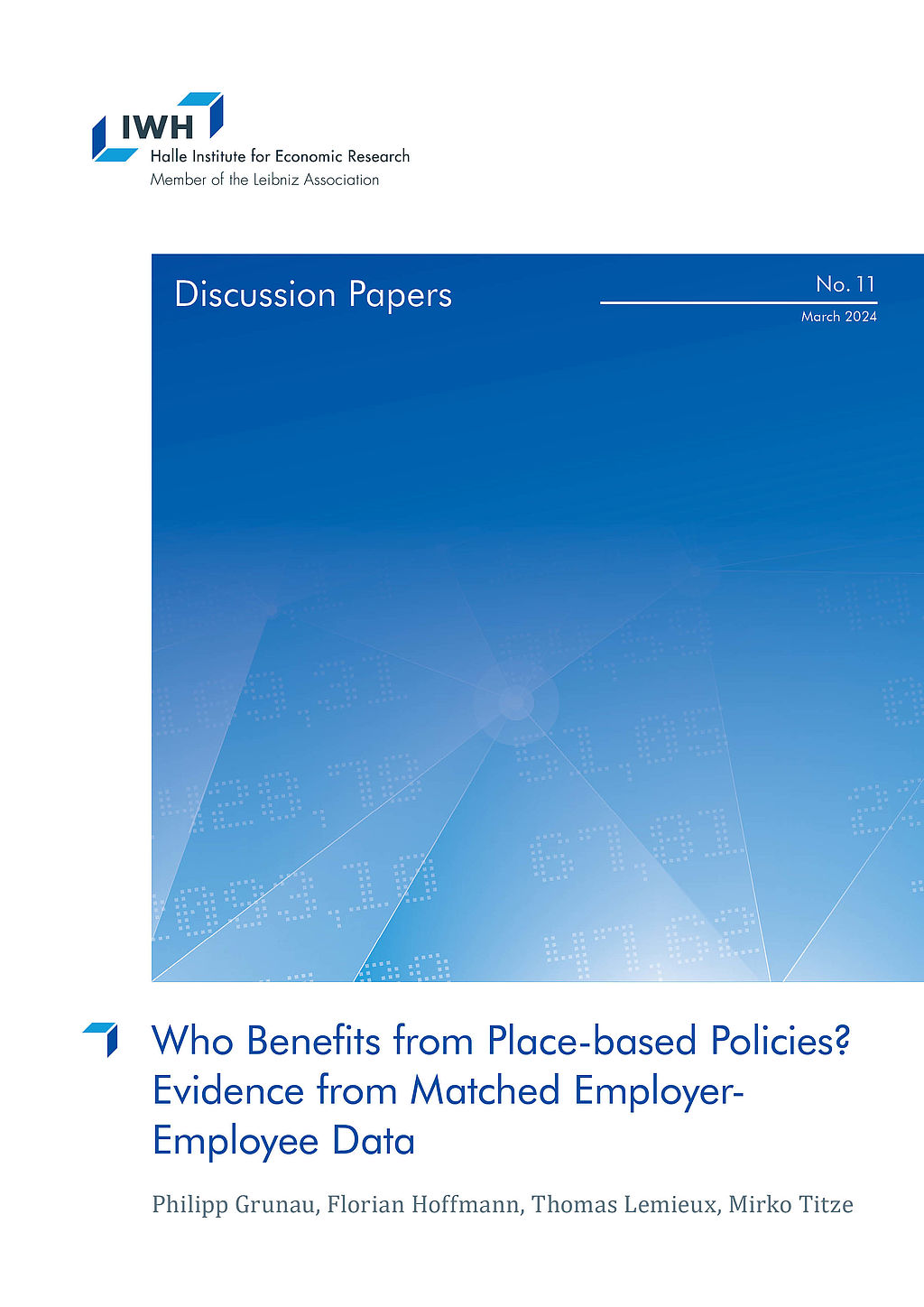
Who Benefits from Place-based Policies? Evidence from Matched Employer-Employee Data
in: IWH Discussion Papers, No. 11, 2024
Abstract
We study the wage and employment effects of a German place-based policy using a research design that exploits conditionally exogenous EU-wide rules governing the program parameters at the regional level. The place-based program subsidizes investments to create jobs with a subsidy rate that varies across labor market regions. The analysis uses matched data on the universe of establishments and their employees, establishment-level panel data on program participation, and regional scores that generate spatial discontinuities in program eligibility and generosity. These rich data enable us to study the incidence of the place-based program on different groups of individuals. We find that the program helps establishments create jobs that disproportionately benefit younger and less-educated workers. Funded establishments increase their wages but, unlike employment, wage gains do not persist in the long run. Employment effects estimated at the local area level are slightly larger than establishment-level estimates, suggesting limited spillover effects. Using subsidy rates as an instrumental variable for actual subsidies indicates that it costs approximately EUR 25,000 to create a new job in the economically disadvantaged areas targeted by the program.
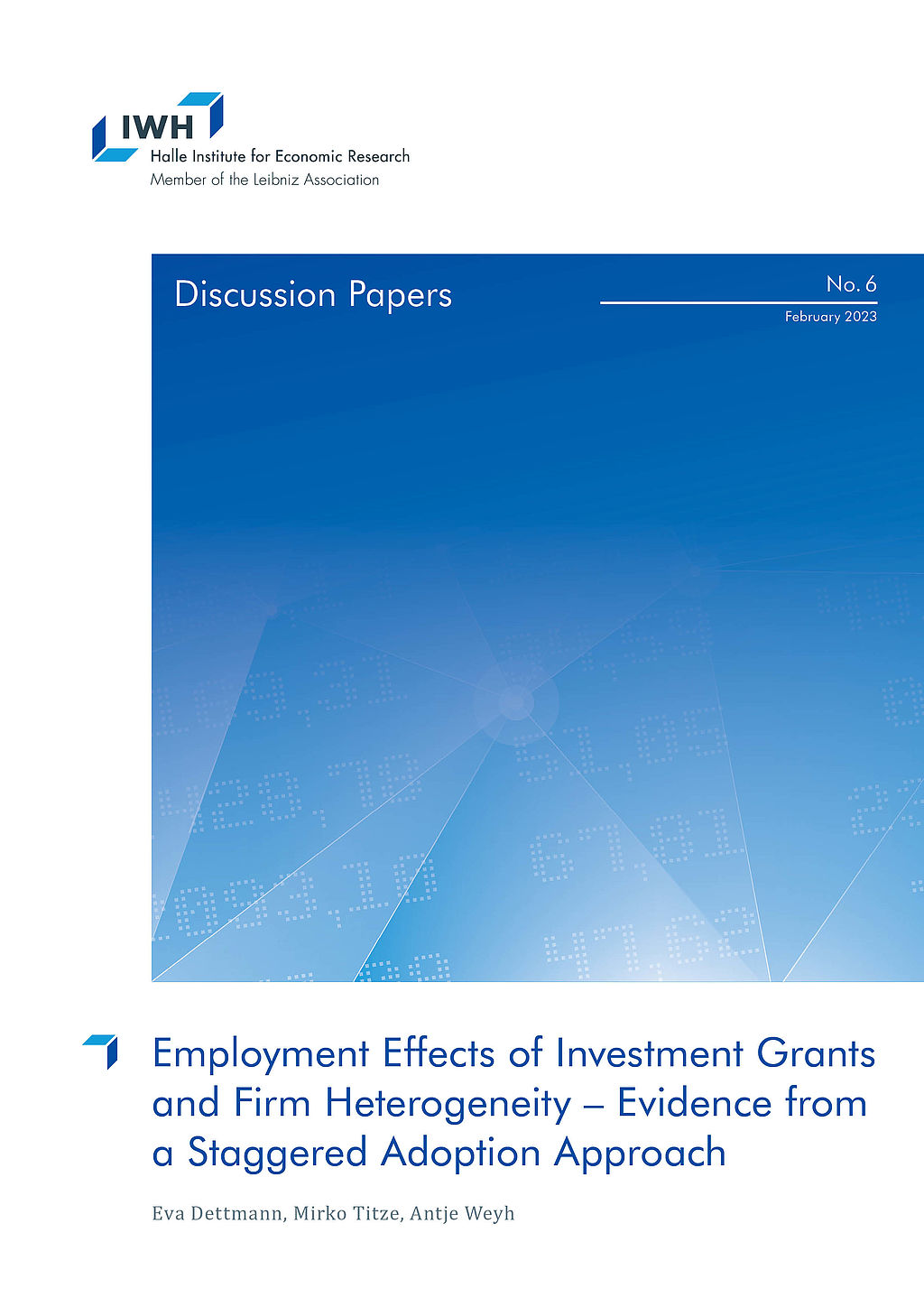
Employment Effects of Investment Grants and Firm Heterogeneity – Evidence from a Staggered Adoption Approach
in: IWH Discussion Papers, No. 6, 2023
Abstract
This study estimates the establishment-level employment effects of investment grants in Germany. In addition to the average treatment effect for the treated, we focus on discrimination in the funding rules as potential source of effect heterogeneity. We combine the difference-in-differences approach of Callaway and Sant’Anna (2021) that explicitly models variation in treatment timing with a ties matching at the cohort level. We observe a positive effect of investment grants on employment development in the full sample. The subsample analysis yields strong evidence for effect heterogeneity due to firm characteristics and the economic environment.
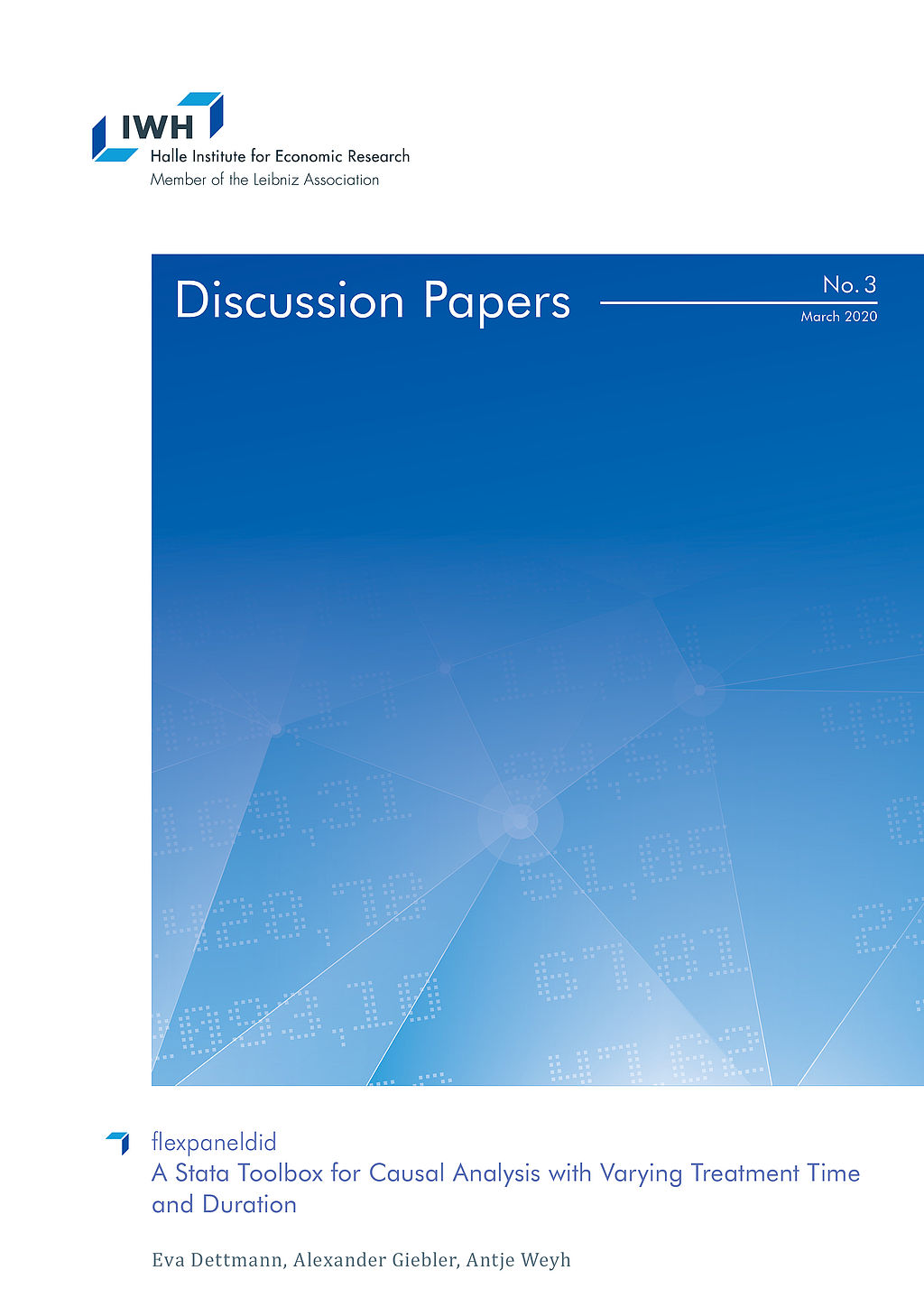
flexpaneldid: A Stata Toolbox for Causal Analysis with Varying Treatment Time and Duration
in: IWH Discussion Papers, No. 3, 2020
Abstract
The paper presents a modification of the matching and difference-in-differences approach of Heckman et al. (1998) for the staggered treatment adoption design and a Stata tool that implements the approach. This flexible conditional difference-in-differences approach is particularly useful for causal analysis of treatments with varying start dates and varying treatment durations. Introducing more flexibility enables the user to consider individual treatment periods for the treated observations and thus circumventing problems arising in canonical difference-in-differences approaches. The open-source flexpaneldid toolbox for Stata implements the developed approach and allows comprehensive robustness checks and quality tests. The core of the paper gives comprehensive examples to explain the use of the commands and its options on the basis of a publicly accessible data set.
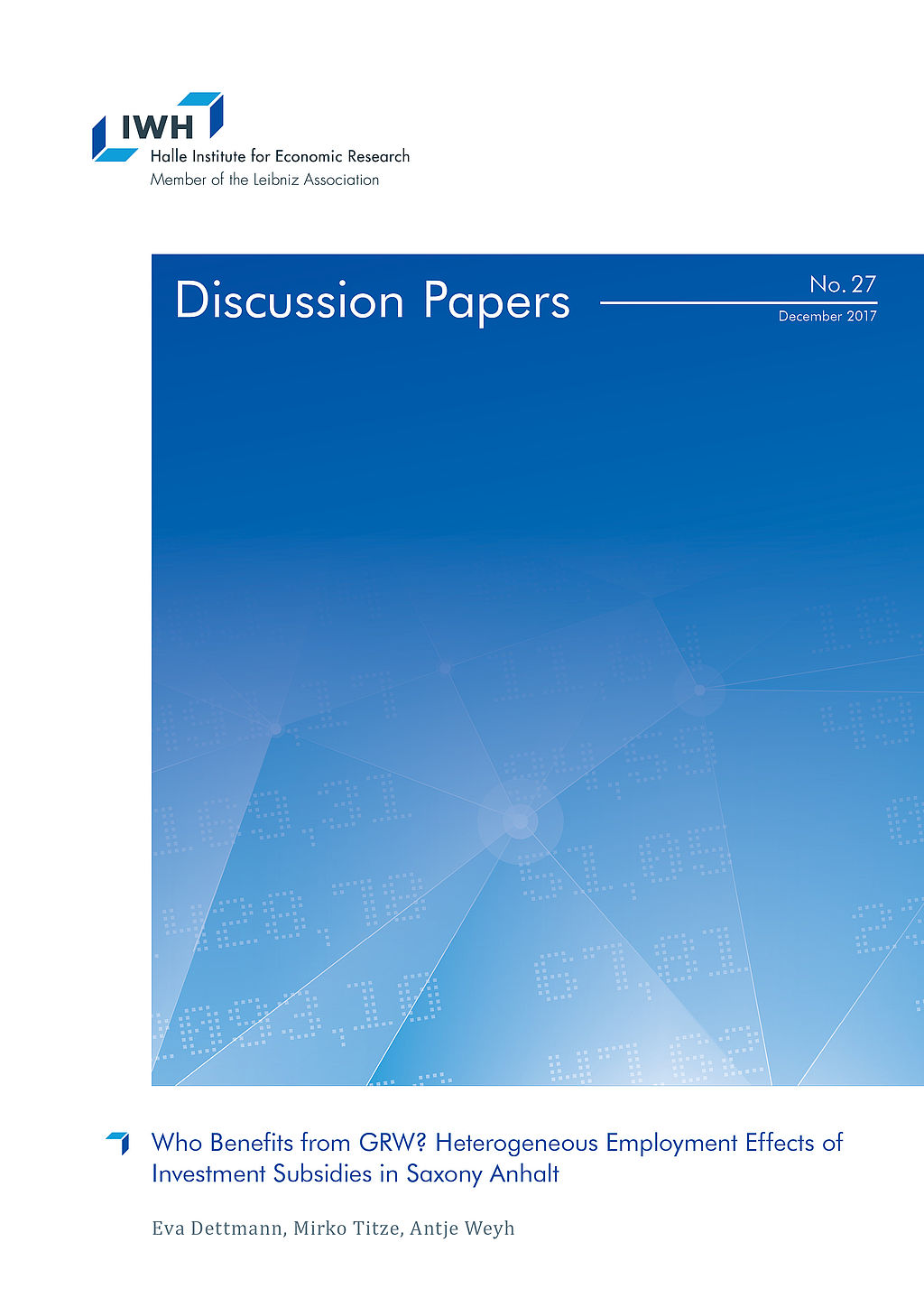
Who Benefits from GRW? Heterogeneous Employment Effects of Investment Subsidies in Saxony Anhalt
in: IWH Discussion Papers, No. 27, 2017
Abstract
The paper estimates the plant level employment effects of investment subsidies in one of the most strongly subsidized German Federal States. We analyze the treated plants as a whole, as well as the influence of heterogeneity in plant characteristics and the economic environment. Modifying the standard matching and difference-in-difference approach, we develop a new procedure that is particularly useful for the evaluation of funding programs with individual treatment phases within the funding period. Our data base combines treatment, employment and regional information from different sources. So, we can relate the absolute effects to the amount of the subsidy paid. The results suggest that investment subsidies have a positive influence on the employment development in absolute and standardized figures – with considerable effect heterogeneity.
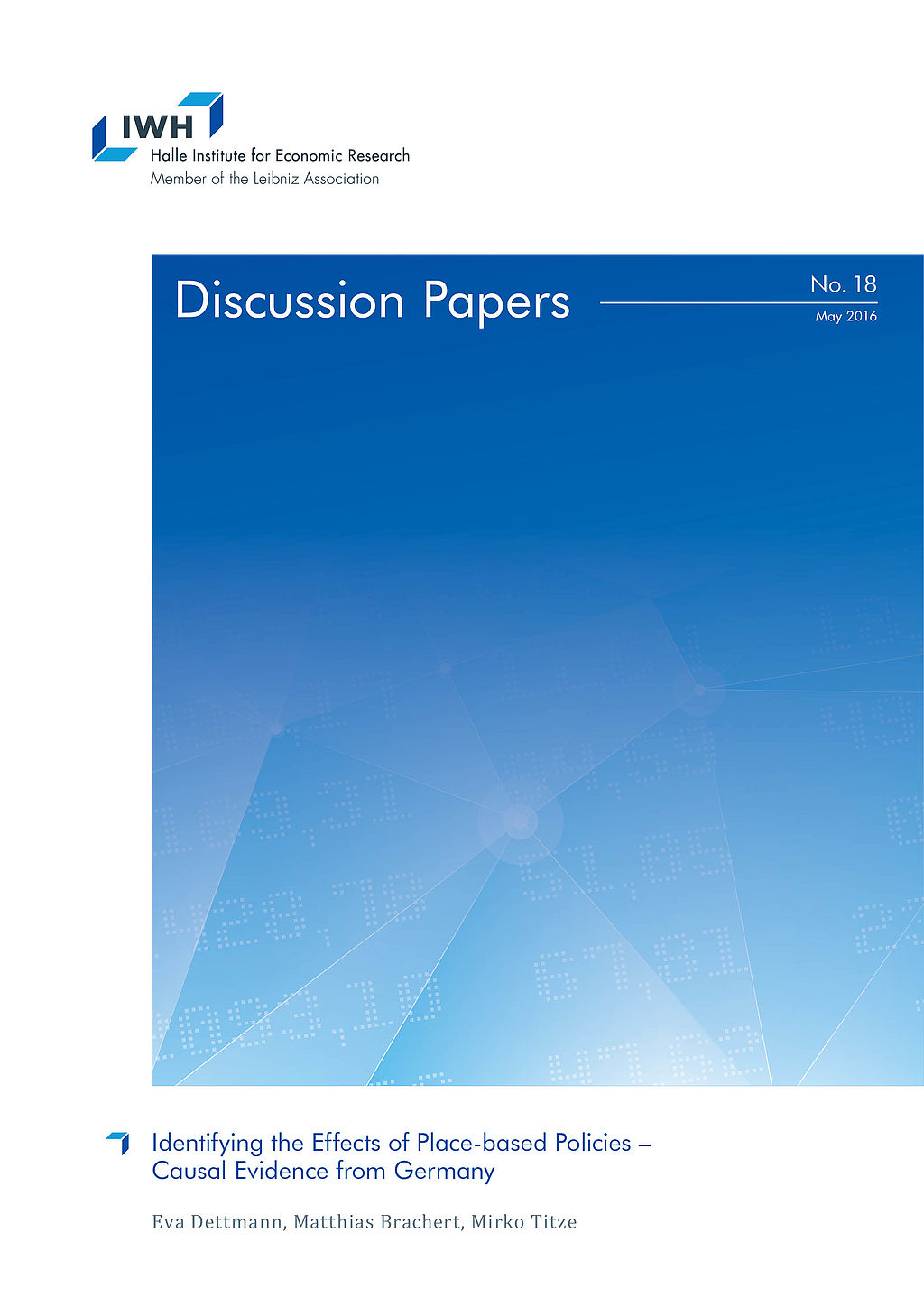
Identifying the Effects of Place-based Policies – Causal Evidence from Germany
in: IWH Discussion Papers, No. 18, 2016
Abstract
The German government provides discretionary investment grants to structurally weak regions to reduce regional disparities. We use a regression discontinuity design that exploits an exogenous discrete jump in the probability of receiving investment grants to identify the causal effects of the investment grant on regional outcomes. We find positive effects for regional gross value-added and productivity growth, but no effects for employment and gross wage growth.











